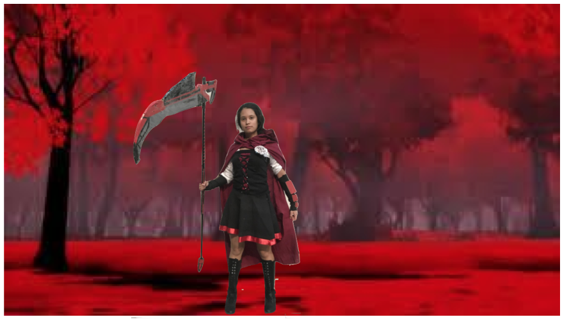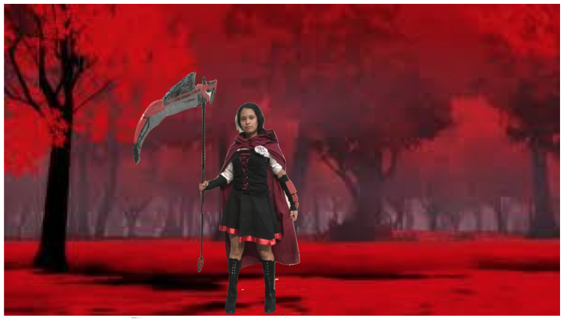
Click to Teach/Click to Learn: Cosplay Costume Creations in Five Easy Steps

Step 1: Get Inspired
In the video below, Texas Theatre Teacher B.K. Goodman shares how he and his students create cosplay costume items from plastic wrap and tape as a lesson in tech theatre. Watch the video to find out how it is done!
Step 2: Create a Mood Board
Did the video get you thinking? There are lots of choices for characters, here are just a few ideas: Greek and Roman mythology, Norse myths, Anime, Manga, Celtic myths, comic book characters, action heros, Disney characters and even the elements of nature.
Choose one and then go research to find loads of images to create your own "mood" or idea board. Here is an example of a mood board for the character of Kim, created for a production of Miss Saigon by NYC costumer Shirlee Idzakovich. The mood board includes textures, colors and images that inspired the designer along with some rough sketches.
Step 3: Refine Your Design
When you're done researching, get your ideas on paper as a rough sketch. Then refine and finish your design using a "croqui" silhouette as the base. Don't forget to add color and texture. Check out this great article on the elements and principles of design to help you think about how to use pattern, shape and repetition to make an original character costume.
Step 4: Take Your Measurements
Get someone to help you take your measurements and record them on this measurement sheet.
Enjoy!
Be sure and take a picture of your costume - and consider using a green screen ap to add a background like Mr. Goodman's students did.

Step 5: Fabricate
Mr. Goodman's students use internet cosplay tutorials to help them design and build costumes. Watch this excerpt of a tutorial created by Kamui Cosplay to see taping techniques that will work for any kind of armor or shaped wear. Once the taping is done you can either paint the finished product to use as is or add craft foam layers as shown in the video to embellish it and make it stronger.
CAUTION: Be sure to follow all safety precautions when using carving tools, heat guns and adhesives.
Share
Love this idea for your troupe? Share this with your troupe director- they may even want to take the online Teacher's Cosplay Workshop on EdTA's Learning Center.
Diving Deeper
Want to learn more about cosplay?
Click on the image below to read Immersion Training by by Elaina Loveland on Dramatics.org and hear about this hobby from several cosplay fans.
What do Cosplay, Designing and Dramaturgy have in common?
Measuring Learning
|
| Above Standard | At Standard | Approaching Standard | Below Standard |
| Mood Board | Mood board presents detailed design ideas that are coordinated and thoughtfully organized, communicating a clear design concept and showing evidence of detailed research. | Mood board presents design ideas that communicate a clear design concept showing evidence of research. | Mood board presents design ideas that suggest a design concept with some evidence of research. | Mood board presents design ideas that are disorganized and/or unsupported by research. |
| Final Costume/ Image | Rendering or Costume Image showcases a unique costume, expertly applying design ideas to enhance and extend the character. | Rendering or Costume Image presents the costume concept utilizing elements of design to communicate a character. | Rendering or Costume Image somewhat communicates a character. | Rendering or Costume Image is limited; a distinct character is unclear. |
Classroom Connections
Cos-Play costuming makes a great student lesson to teach in 4-5 class periods. To view or download the full lesson all set to go on a PowerPoint suitable for use in a classroom, go here.This lesson is suitable for middle years or secondary students of all ages and experience.
Standards:
Middle Years
TH:Cr3.1.8.c
Implement and refine a planned technical design using simple technology during the rehearsal process for a devised or scripted drama/theatre work.
TH:Cn11.2.8.a. Identify and use artifacts from a time period and place to develop performance and design choices in a drama/theatre work.
HS Proficient
TH:Cr3.1.I.c. Refine technical design choices to support the story and emotional impact of a devised or scripted drama/theatre work.
TH:Cn11.2.I.b. Use basic theatre research methods to better understand the social and cultural background of a drama/theatre work.
HS Accomplished
TH:Cr3.1.II.c. Re-imagine and revise technical design choices during the course of a rehearsal process to enhance the story and emotional impact of a devised or scripted drama/theatre work.
TH:Cn11.2.II.b. Explore how personal beliefs and biases can affect the interpretation of research data applied in a drama/theatre work.
HS Advanced
TH:Cr3.1.III.c Apply a high level of technical proficiencies to the rehearsal process to support the story and emotional impact of a devised or scripted drama/theatre work.
TH:Cn11.2.III.b. Present and support an opinion about the social cultural and historical understandings of a drama/theatre work based on critical research.
| Access Date | Quiz Result | Score | Actions |
|---|
Learning Center
- Webinars
- Adjudication Trainings
- Featured Courses
- Full Course List
- Lesson Plan Library
- Click to Teach Interactive Online Lessons
- Resources for New Theatre Teachers
- Technical Theatre Educator's Manual
- Connected Arts Networks
- Diverse Resources for Theatre Education
- Behind the Scenes Technical Theatre Curriculum
- Social & Emotional Learning
- Additional Standards Based Instructional Resources
- Search the Catalog
- Cart (0 items)
Full Site Search
Membership Benefits
Join EdTA for full access to our professional development and standards-based teaching resources, including:
- 300+ lesson plans
- Click to Teach online lessons
- K-12 curriculum
- Webinars
- And more!




